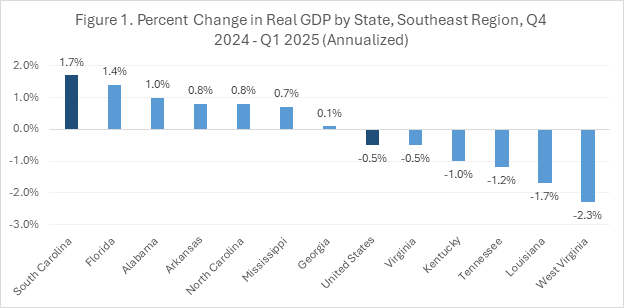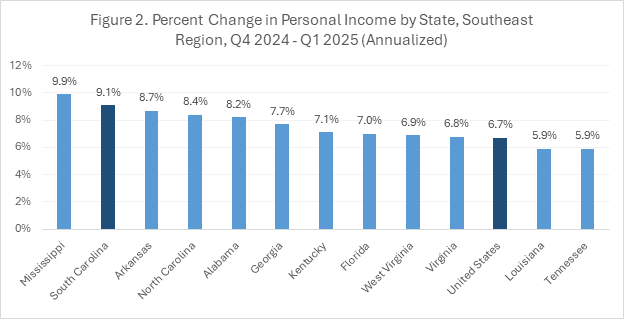GDP & Personal Income, 1st Quarter 2025
By Lainey Stalnaker, Data Analytics Writer

Introduction
Two of the most critical indicators of economic health are gross domestic product (GDP) and personal income. GDP is the market value of all final goods and services produced within a given period of time. It is calculated by adding personal consumption and investments, government spending and investments, and net exports. The greater the GDP of a country, state, or county, the larger its economy.
Personal income is income from all sources, including the typical earnings from wages and salaries, plus employer contributions to employee pension and insurance funds. It also includes income from interest, dividends, and rent (i.e. income from assets), and transfers from the government, such as social security or financial aid payments. Contributions to government social insurance programs are excluded.
GDP
During quarter one of 2025 (Q1), South Carolina recorded significant growth for both GDP and personal income.1 South Carolina’s real GDP, which accounts for inflation, increased at an annualized rate of 1.7 percent, outpacing all other states and the District of Columbia. National GDP, in comparison, contracted in Q1, falling at an annualized rate of 0.5 percent. Across the Southeast, GDP activity was mixed. Six states other than SC recorded GDP growth, while five saw a decline, as shown in Figure 1.

In South Carolina, the real estate and rental and leasing sector was by far the largest contributor to GDP growth, accounting for 0.88 of the 1.7 percentage points total. The information sector contributed 0.38 points, and in third, the construction sector contributed 0.32 points.
Personal Income
At an annualized rate of 9.1 percent, South Carolina ranked fourth in the country for personal income growth in Q1. The largest contributors by sector were construction (0.55 of the 9.1 percentage points total growth), administrative and support and waste management and remediation services (0.40), and finance and insurance (0.35). In the Southeast region only Mississippi, with growth of 9.9 percent, surpassed South Carolina. All states in the region recorded personal income growth for the quarter. In the U.S., personal income increased at an annualized rate of 6.7 percent. All of these results appear in Figure 2, ahead.

Conclusion
South Carolina experienced strong GDP and personal income growth in Q1, exceeding the national average for both metrics and outperforming most other states in the Southeast, as well. Such rapid increases point to the strength of the state’s economy and a bright future for South Carolina workers.
